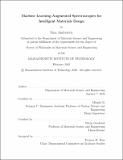| dc.description.abstract | Neutron and photon scattering and spectroscopy represent two fundamental categories of characterization techniques used to interrogate materials’ structural and dynamical properties at atomic to mesoscopic length scales. As advances at scientific user facilities enable the collection of ever larger data volumes in higher-dimensional parameter spaces, the design, analysis, and interpretation of such experiments becomes both increasingly valuable and complex. At the same time, interest in novel functional and quantum materials for next-generation technologies, including dissipationless electronics, energy harvesting, and quantum computing, demands an understanding of unconventional or emergent properties beyond the scope of many approximate models. Machine learning methods are designed to leverage large, highdimensional datasets in order to detect underlying patterns and make informed predictions on related tasks. Thus, integration of these data-driven methods with neutron and photon spectroscopies has the potential to improve experimental design, accelerate and enhance data analysis, and uncover insights beyond traditional models.
This thesis work demonstrates the proposed integration of machine learning to augment experimental design and analysis in the context of four different scattering and spectroscopic techniques. First, we use Euclidean neural networks to predict materials’ vibrational properties directly from the atomic masses and positions of their constituent atoms, highlighting the importance of using effective materials data representations to strengthen model performance and interpretability. We then consider how machine learning methods can be applied to develop effective, low-dimensional representations of materials’ spectral signatures, which we exemplify through unsupervised representation learning of Raman spectra. Such learned representations are proposed as efficient prediction targets for supervised learning from relevant structural or chemical attributes, or as convenient parameter spaces for optimization of physical models. We illustrate the latter by training a variational autoencoder to retrieve the sample parameters of proximity-coupled heterostructures from their polarized neutron reflectometry profiles with high resolution. Finally, we study the capacity of machine learning models to extract “hidden” insights from spectral data by developing a neural network classifier of materials’ electronic band topology directly from X-ray absorption near-edge structure spectra. While we develop analysis frameworks with specific applications in mind, the proposed methodologies are expected to apply more broadly to diverse scattering and spectroscopic techniques. | |
